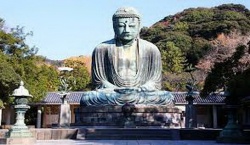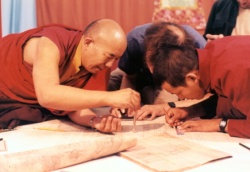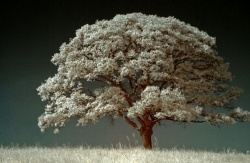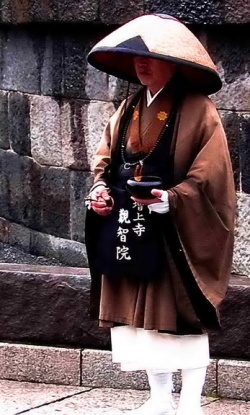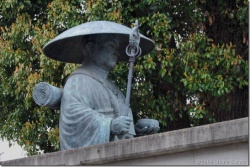Kamakura Buddha
The Great Buddha of Kamakura is a bronze statue of Amida Buddha that is located on the grounds of the Kotokuin Temple. With a height of 13.35 meters, it is the second largest Buddha statue in Japan (the largest is located in the Todaiji Temple in Nara).
The statue was cast in 1252 and originally located inside a large temple hall. However, the temple buildings were washed away by a tsunami tidal wave in the end of the 15th century, and since then the Buddha stands in the open air.
Kōtoku-in (高徳院?) is a Buddhist temple of the Jōdo-shū sect in the city of Kamakura in Kanagawa Prefecture, Japan.
The temple is renowned for its "Great Buddha" (大仏 Daibutsu?), a monumental outdoor bronze statue of Amida Buddha which is one of the most famous icons of Japan.
he Great Buddha of Kamakura is a monumental outdoor bronze statue of Amitābha Buddha located at the Kōtoku-in Temple in Kamakura, Kanagawa Prefecture, Japan.
The bronze statue probably dates from 1252, in the Kamakura period, according to temple records.
It was preceded by a giant wooden Buddha, which was completed in 1243 after ten years of continuous labor, the funds having been raised by Lady Inada (Inada-no-Tsubone) and the Buddhist priest Jōkō of Tōtōmi.
That wooden statue was damaged by a storm in 1248, and the hall containing it was destroyed, so Jōkō suggested making another statue of bronze, and the huge amount of money necessary for this and for a new hall was raised for the project.
The bronze image was probably cast by Ōno Gorōemon or Tanji Hisatomo, both leading casters of the time.
At one time, the statue was gilded. There are still traces of gold leaf near the statue's ears. It is unclear, however, whether the statue constructed in 1252 is the same statue as the present statue.
The hall was destroyed by a storm in 1334, was rebuilt, and was damaged by yet another storm in 1369, and was rebuilt yet again. The last building housing the statue was washed away in the tsunami of September 20, 1498, during the Muromachi period. Since then, the Great Buddha has stood in the open air.
The statue is approximately 13.35 meters tall including the base and weighs approximately 93 tonnes. The statue is hollow, and visitors can view the interior. Many visitors over the years have left graffiti on the inside of the statue.
At one time, there were thirty-two bronze lotus petals at the base of the statue, but only four remain, and they are no longer in place.
A notice at the entrance to the grounds reads, "Stranger, whosoever thou art and whatsoever be thy creed, when thou enterest this sanctuary remember thou treadest upon ground hallowed by the worship of ages.
This is the Temple of Bhudda (sic) and the gate of the eternal, and should therefore be entered with reverence."
The Great Kanto Earthquake of 1923 destroyed the base the statue sits upon, but the base was repaired in 1925. Repairs to the statue were carried out in 1960-1961, when the neck was strengthened and measures were taken to protect it from earthquakes.
The Great Buddha of Kamakura (Daibutsu in Japanese) is a monumental outdoor bronze statue of Amida Buddha in the city of Kamakura, Japan.
Seated serenely in the grounds of Kotokuin, a Buddhist temple of the Pure Land sect, the Great Buddha is one of the icons of Japan.
At 13.35 meters high and weighing 93 tons, the Daibutsu is the second largest monumental Buddha in Japan (after the one at Todaiji in Nara) and to many, the most impressive.
The Diabutsu was cast in 1252 in the Kamakura period and was originally housed inside a temple, as in Nara. But a huge tsunami washed away the wooden structure sometime in the late 15th century, and the statue has sat out in nature ever since.
The Great Buddha is seated in the lotus position with his hands forming the Dhyani Mudra, the gesture of meditation. With a serene expression and a beautiful backdrop of wooded hills, the Daibutsu is a truly spectacular sight.
The Daibutsu is Amida Buddha, who is the focus of Pure Land Buddhism. Originating in China, this sect gained prominence in Japan in the 12th century and remains very popular today.
The central teaching is that through devotion to Amida Buddha, expressed through mantras and sincerity of heart, one will go to the Pure Land or "Western Paradise" after death - a pleasant realm from which it is easy to attain nirvana.
Kamakura a site of ancient pilgrimage on the west coast of the bay of Yokohama, south of Tokyo; among its many shrines is a famous and colossal image of the Buddha, which was in place as early as 1252.
‘Kamakura’ is pronounced with an even stress on each syllable in Japanese: this needs observing in order to protect Kipling’s original metre
